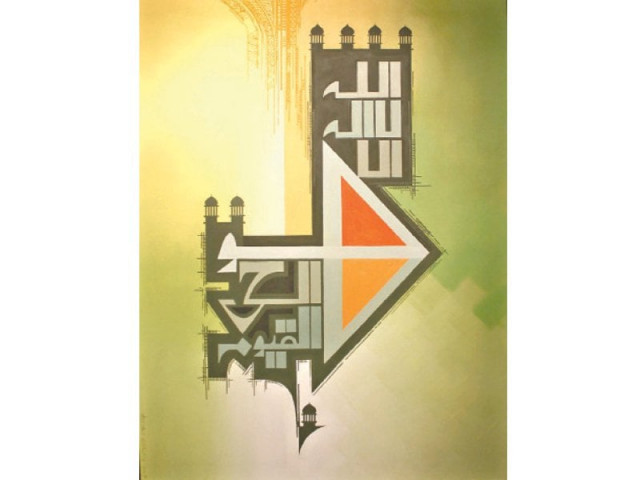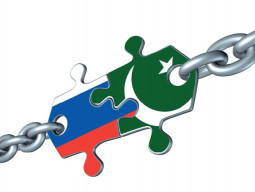
Artist and poet Aslam Kamal presented three of his pieces to the National Art Gallery of the Pakistan National Council of the Arts during a ceremony on Thursday.
Two of the pieces are calligraphies painted in vibrant hues, geometrical and cubic patterns offset by miniature symbols of Islamic architecture in the backdrop while the third piece is a painting which emulates the revolutionary poet Faiz Ahmed Faiz.
A large oil painting is based on Faiz’s famous poem “Aaj bazaar mein pa ba jolan chalo,” (Let us walk in public in shackles today) illustrating his resilience through his trials while in exile and during military dictatorships, depicting him in the garb of a mystic. Although his body is chained, Faiz seems to be ascending the mundane world while a dagger lies in his path.
Calligraphy is a pre-Islamic era art, according to Kamal. “There is a common misconception that Muslims introduced the artistic medium to the world whereas it was actually discovered in the teachings of Prophet Jesus Christ (AS) in Egypt before spreading elsewhere,” he said while speaking on the history of calligraphy at the Pakistan National Council of the Arts (PNCA) on Thursday.
However, Kamal pointed out, the practice remained underappreciated till centuries later when Prophet Muhammad (PBUH) employed around 42 of his companions to document the divine revelation. “This is when the practice picked up momentum and the word spread much faster,” said Kamal.
“We pride ourselves on the calligraphy created by noted artists and it is only when a calligrapher becomes engrossed in his work and innovates that the final product transcends ordinary writing.” Kamal donated three of his paintings to the National Art Gallery.
Kamal, who has also illustrated the cover of Faiz’s book “Nuskha hai Wafa,” underlined Faiz’s ideals and philosophy, drawing parallels with the poetry of Allama Iqbal.
He pointed to the various similarities in the poetic expressions of both the greatest poets, saying that the latter still remains undecorated for his contribution to Urdu literature.
His figurative paintings, poetic illustrations and calligraphy works, when coupled with lyrical text, exude an esoteric, spiritual feel.
Through a multimedia presentation, Kamal showcased some of his pieces inspired by select verses of Faiz and Iqbal. He highlighted their love for peace and humanity.
Students of various universities and colleges attended the lecture. Kamal also donated two of his books “Gard Posh” and “Islami Khatati to the gallery.
Kamal has received appreciation for his work at home and abroad. He is an expert on the poetry of Iqbal and invented “Khat-i-Kamal,” his signature style of calligraphy. The Aiwan-i-Quaid at the F-9 Park houses about 50 of his paintings.
He is also a recipient of the Pride of Performance presidential award and has set a world record by designing over 20,000 book covers.
Speaking on the occasion, Pakistan National Council of the Arts (PNCA) Director-General Mashood Ahmed Mirza said Pakistan is heir to a rich cultural heritage. “Our poets, intellectuals, artists and artisans are our pride and asset.”
While acknowledging the contribution of the painter, he said Kamal has rendered valuable services for the promotion of art, especially calligraphy.
Through his artwork, he has reflected the vision and philosophy of great poets like Faiz and Iqbal.
Published in The Express Tribune, June 6th, 2014.

















COMMENTS
Comments are moderated and generally will be posted if they are on-topic and not abusive.
For more information, please see our Comments FAQ